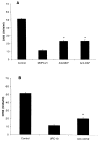Complement regulatory activity of normal human intraocular fluid is mediated by MCP, DAF, and CD59
- PMID: 11095615
- PMCID: PMC1821086
Complement regulatory activity of normal human intraocular fluid is mediated by MCP, DAF, and CD59
Abstract
Purpose: To identify the molecules in normal human intraocular fluid (aqueous humor and vitreous) that inhibit the functional activity of the complement system.
Methods: Aqueous humor and vitreous were obtained from patients with noninflammatory ocular disease at the time of surgery. Samples were incubated with normal human serum (NHS), and the mixture assayed for inhibition of the classical and alternative complement pathways using standard CH(50) and AH(50) hemolytic assays, respectively. Both aqueous humor and vitreous were fractionated by microconcentrators and size exclusion column chromatography. The inhibitory molecules were identified by immunoblotting as well as by studying the effect of depletion of membrane cofactor protein (MCP), decay-accelerating factor (DAF), and CD59 on inhibitory activity.
Results: Both aqueous humor and vitreous inhibited the activity of the classical pathway (CH(50)). Microcentrifugation revealed the major inhibitory activity resided in the fraction with an M(r) >/= 3 kDa. Chromatography on an S-100-HR column demonstrated that the most potent inhibition was associated with the high-molecular-weight fractions (>/=19.5 kDa). In contrast to unfractionated aqueous and vitreous, fractions with an M(r) >/= 3 kDa also had an inhibitory effect on the alternative pathway activity (AH(50)). The complement regulatory activity in normal human intraocular fluid was partially blocked by monoclonal antibodies against MCP, DAF, and CD59. Immunoblot analysis confirmed the presence of these three molecules in normal intraocular fluid.
Conclusions: Our results demonstrate that normal human intraocular fluid (aqueous humor and vitreous) contains complement inhibitory factors. Furthermore, the high-molecular-weight factors appear to be the soluble forms of MCP, DAF, and CD59.
Figures




Similar articles
-
Protection of xenogeneic cells from human complement-mediated lysis by the expression of human DAF, CD59 and MCP.FEMS Immunol Med Microbiol. 2001 Oct;31(3):203-9. doi: 10.1111/j.1574-695X.2001.tb00521.x. FEMS Immunol Med Microbiol. 2001. PMID: 11720816
-
Chronic low level complement activation within the eye is controlled by intraocular complement regulatory proteins.Invest Ophthalmol Vis Sci. 2000 Oct;41(11):3492-502. Invest Ophthalmol Vis Sci. 2000. PMID: 11006244 Free PMC article.
-
Complement regulatory proteins on the sperm surface: relevance to sperm motility.Am J Reprod Immunol. 1998 Apr;39(4):243-8. doi: 10.1111/j.1600-0897.1998.tb00360.x. Am J Reprod Immunol. 1998. PMID: 9553648
-
Membrane complement regulatory proteins: insight from animal studies and relevance to human diseases.Int Immunopharmacol. 2001 Mar;1(3):445-59. doi: 10.1016/s1567-5769(00)00043-6. Int Immunopharmacol. 2001. PMID: 11367529 Review.
-
The complement system in human reproduction.Am J Reprod Immunol. 1992 Apr-May;27(3-4):145-55. doi: 10.1111/j.1600-0897.1992.tb00742.x. Am J Reprod Immunol. 1992. PMID: 1384536 Review.
Cited by
-
Galectin-9-mediated protection from allo-specific T cells as a mechanism of immune privilege of corneal allografts.PLoS One. 2013 May 7;8(5):e63620. doi: 10.1371/journal.pone.0063620. Print 2013. PLoS One. 2013. PMID: 23667648 Free PMC article.
-
The role of complement in ocular pathology.Semin Immunopathol. 2008 Apr;30(2):85-95. doi: 10.1007/s00281-008-0110-y. Epub 2008 Feb 26. Semin Immunopathol. 2008. PMID: 18299835 Free PMC article. Review.
-
The role of complement system in ocular diseases including uveitis and macular degeneration.Mol Immunol. 2007 Sep;44(16):3901-8. doi: 10.1016/j.molimm.2007.06.145. Mol Immunol. 2007. PMID: 17768108 Free PMC article. Review.
-
Mechanisms of immune privilege in the anterior segment of the eye: what we learn from corneal transplantation.J Ocul Biol Dis Infor. 2008 Dec;1(2-4):94-100. doi: 10.1007/s12177-008-9010-6. Epub 2008 Aug 8. J Ocul Biol Dis Infor. 2008. PMID: 20072639 Free PMC article.
-
A caveat for T cell transfer studies: generation of cytotoxic anti-Thy1.2 antibodies in Thy1.1 congenic mice given Thy1.2+ tumors or T cells.J Leukoc Biol. 2011 Feb;89(2):291-300. doi: 10.1189/jlb.0610333. Epub 2010 Oct 19. J Leukoc Biol. 2011. PMID: 20959413 Free PMC article.
References
-
- Atkinson JP, Frank MM. Complement. In: Parker CW, editor. Clinical Immunology. Philadelphia: WB Saunders; 1980. pp. 219–271.
-
- Muller-Eberhard HJ. Molecular organization and function of the complement system. Annu Rev Biochem. 1988;57:321–347. - PubMed
-
- Liszewski MK, Farries TC, Lublin DM, Rooney IA, Atkinson JP. Control of the complement system. Adv Immunol. 1996;61:201–283. - PubMed
-
- Atkinson JP, Farries T. Separation of self from non-self in the complement system. Immunol Today. 1987;8:212–215. - PubMed
-
- Lublin DM, Atkinson JP. Decay-accelerating factor and membrane cofactor protein. Curr Topics Microbiol Immunol. 1987;153:123–145. - PubMed
Publication types
MeSH terms
Substances
Grants and funding
LinkOut - more resources
Full Text Sources
Other Literature Sources
Miscellaneous

